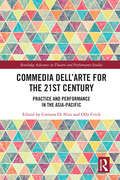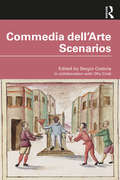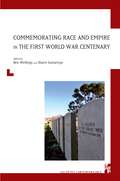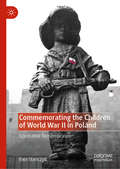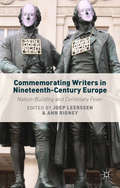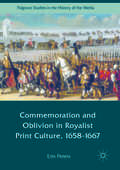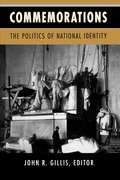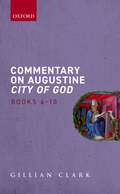- Table View
- List View
Commedia dell’Arte for the 21st Century: Practice and Performance in the Asia-Pacific (Routledge Advances in Theatre & Performance Studies)
by Corinna Di Niro Olly CrickThis book discusses the evolution of Commedia dell’Arte in the Asia-Pacific where through the process of reinvention and recreation it has emerged as a variety of hybrids and praxes, all in some ways faithful to the recreated European genre. The contributors in this collection chart their own training in the field and document their strategies for engaging with this form of theatre. In doing so, this book examines the current thoughts, ideas, and perceptions of Commedia – a long-standing theatre genre, originating in a European-based collision between neo-classical drama and oral tradition. The contributing artists, directors, teachers, scholars and theatre-makers give insight into working styles, performance ideas, craft techniques and ways to engage an audience for whom Commedia is not part of their day-to-day culture. The volume presents case studies by current practitioners, some who have trained under known Commedia ‘masters’ (e.g. Lecoq, Boso, Mazzone-Clementi and Fava) and have returned to their country of origin where they have developed their performance and teaching praxis, and others (e.g. travelling from Europe to Japan, Thailand, Singapore and China) who have discovered access points to share or teach Commedia in places where it was previously not known. This book will be of great interest to students and scholars in Performing arts, Italian studies, and History as well as practitioners in Commedia dell’Arte.
Commedia dell'Arte Scenarios
by Sergio CostolaCommedia dell'Arte Scenarios gathers together a collection of scenarios from some of the most important Commedia dell'Arte manuscripts, many of which have never been published in English before. Each script is accompanied by an editorial commentary that sets out its historical context and the backstory of its composition and dramaturgical strategies, as well as scene summaries, and character and properties lists. These supplementary materials not only create a comprehensive picture of each script’s performance methods but also offer a blueprint for readers looking to perform the scenarios as part of their own study or professional practice. This collection offers scholars, performers and students a wealth of original performance texts that brig to life one of the most foundational performance genres in world theatre.
Commedia dell'Arte Scenarios
by Sergio Costola Olly CrickCommedia dell'Arte Scenarios gathers together a collection of scenarios from some of the most important Commedia dell'Arte manuscripts, many of which have never been published in English before. Each script is accompanied by an editorial commentary that sets out its historical context and the backstory of its composition and dramaturgical strategies, as well as scene summaries, and character and properties lists. These supplementary materials not only create a comprehensive picture of each script’s performance methods but also offer a blueprint for readers looking to perform the scenarios as part of their own study or professional practice. This collection offers scholars, performers and students a wealth of original performance texts that brig to life one of the most foundational performance genres in world theatre.
Commemorating Power in Early Medieval Saxony: Writing and Rewriting the Past at Gandersheim and Quedlinburg (Studies in German History)
by Sarah GreerIn the early medieval world, the way people remembered the past changed how they saw the present. New accounts of former leaders and their deeds could strengthen their successors, establish novel claims to power, or criticize the current ruler. After 888, when the Carolingian Empire fractured into the smaller kingdoms of medieval western Europe, memory became a vital tool for those seeking to claim royal power for themselves. Commemorating Power in Early Medieval Saxony looks at how the past was evoked for political purposes under a new Saxon dynasty, the Ottonians, who came to dominate post-Carolingian Europe as the rulers of a new empire in Germany and Italy. With the accession of the first Ottonian king, Henry I, in 919, sites commemorating the king's family came to the foreground of the medieval German kingdom. The most remarkable of these were two convents of monastic women, Gandersheim and Quedlinburg, whose prominence and prestige in Ottonian politics have been seen as exceptional in the history of early medieval western Europe. In this volume, Sarah Greer offers a fresh interpretation of how these convents became central sites in the new Ottonian empire by revealing how the women in these communities themselves were skilful political actors who were more than capable of manipulating memory for their own benefit. In this first major study in English of how these Saxon convents functioned as memorial centres, Greer presents a new vision of the first German dynasty, one characterized by contingency, versatility, and the power of the past.
Commemorating Power in Early Medieval Saxony: Writing and Rewriting the Past at Gandersheim and Quedlinburg (Studies in German History)
by Sarah GreerIn the early medieval world, the way people remembered the past changed how they saw the present. New accounts of former leaders and their deeds could strengthen their successors, establish novel claims to power, or criticize the current ruler. After 888, when the Carolingian Empire fractured into the smaller kingdoms of medieval western Europe, memory became a vital tool for those seeking to claim royal power for themselves. Commemorating Power in Early Medieval Saxony looks at how the past was evoked for political purposes under a new Saxon dynasty, the Ottonians, who came to dominate post-Carolingian Europe as the rulers of a new empire in Germany and Italy. With the accession of the first Ottonian king, Henry I, in 919, sites commemorating the king's family came to the foreground of the medieval German kingdom. The most remarkable of these were two convents of monastic women, Gandersheim and Quedlinburg, whose prominence and prestige in Ottonian politics have been seen as exceptional in the history of early medieval western Europe. In this volume, Sarah Greer offers a fresh interpretation of how these convents became central sites in the new Ottonian empire by revealing how the women in these communities themselves were skilful political actors who were more than capable of manipulating memory for their own benefit. In this first major study in English of how these Saxon convents functioned as memorial centres, Greer presents a new vision of the first German dynasty, one characterized by contingency, versatility, and the power of the past.
Commemorating Race and Empire in the First World War Centenary (Provence University Press)
First World War commemoration in Europe has been framed as a moment of national trial and as a collective European tragedy. But the ‘Great War for Civilisation’ was more than just a European conflict. It was in fact a global war, a clash of empires that began a process of nationalist agitation against imperial polities and the racisms that underpinned them in Asia, Africa and beyond. Despite the global context of Centenary commemorative activity these events remain framed by national and state imaginaries and ones in which the ideas about nation, race and imperialism that animated and dominated men and women during the Great War sit uncomfortably with modern sensibilities. By drawing on original archival research, translations from French and Mandarin into English and by employing multidisciplinary conceptual frames of analysis this exciting and innovative volume explores how race and empire, and racism and imperialism, were commemorated or forgotten during the First World War Centenary.
Commemorating the Children of World War II in Poland: Combative Remembrance
by Ewa StańczykThis book explores contemporary debates surrounding Poland’s 'war children', that is the young victims, participants and survivors of the Second World War. It focuses on the period after 2001, which saw the emergence of the two main political parties that were to dictate the tone of the politics of memory for more than a decade. The book shows that 2001 marked a caesura in Poland’s post-Communist history, as this was when the past took center stage in Polish political life. It argues that during this period a distinct culture of commemoration emerged in Poland – one that was not only governed by what the electorate wanted to hear and see, but also fueled by emotions.
Commemorating the Dead in Late Medieval Strasbourg: The Cathedral's Book of Donors and Its Use (1320-1521) (Church, Faith and Culture in the Medieval West)
by Charlotte A. StanfordThe Book of Donors for Strasbourg cathedral is an extraordinary medieval document dating from ca. 1320-1520, with 6,954 entries from artisan, merchant and aristocratic classes. These individuals listed gifts to the cathedral construction fund given in exchange for prayers for the donors' souls. The construction administrators (the Oeuvre Notre-Dame) also built a chapel dedicated to the Blessed Virgin Mary in the nave that housed the book and showcased prayers and masses for the building benefactors. Chapel, book and west front project formed a three part commemorative strategy that appealed to the faithful of the city and successfully competed against other religious establishments also offering memorial services. Charlotte A. Stanford's study is the first to comprehensively analyze the unpublished Book of Donors manuscript and show the types and patterns of gifts made to the cathedral. It also compares these gift entries with those in earlier obituary records kept by the cathedral canons, as well as other medieval obituary notices kept by parish churches and convents in Strasbourg. Analysis of the Book of Donors notes the increase of personal details and requests in fifteenth-century entries and discusses the different memorial opportunities available to the devout. This study draws a vivid picture of life in late medieval Strasbourg as seen through the lens of devotional and memorial practices, and will be of particular interest to scholars of art history, memory, and medieval urban life.
Commemorating the Dead in Late Medieval Strasbourg: The Cathedral's Book of Donors and Its Use (1320-1521) (Church, Faith and Culture in the Medieval West)
by Charlotte A. StanfordThe Book of Donors for Strasbourg cathedral is an extraordinary medieval document dating from ca. 1320-1520, with 6,954 entries from artisan, merchant and aristocratic classes. These individuals listed gifts to the cathedral construction fund given in exchange for prayers for the donors' souls. The construction administrators (the Oeuvre Notre-Dame) also built a chapel dedicated to the Blessed Virgin Mary in the nave that housed the book and showcased prayers and masses for the building benefactors. Chapel, book and west front project formed a three part commemorative strategy that appealed to the faithful of the city and successfully competed against other religious establishments also offering memorial services. Charlotte A. Stanford's study is the first to comprehensively analyze the unpublished Book of Donors manuscript and show the types and patterns of gifts made to the cathedral. It also compares these gift entries with those in earlier obituary records kept by the cathedral canons, as well as other medieval obituary notices kept by parish churches and convents in Strasbourg. Analysis of the Book of Donors notes the increase of personal details and requests in fifteenth-century entries and discusses the different memorial opportunities available to the devout. This study draws a vivid picture of life in late medieval Strasbourg as seen through the lens of devotional and memorial practices, and will be of particular interest to scholars of art history, memory, and medieval urban life.
Commemorating the Polish Renaissance Child: Funeral Monuments and their European Context
by Jeannie LabnoThe study of funeral monuments is a growing field, but monuments erected to commemorate children have so far received little attention. Whilst the practice of erecting monuments to the dead was widespread across Renaissance Europe, the vast majority of these commemorated adults, with children generally only appearing as part of their parents' memorials. However, as this study reveals, in Poland there developed a very different tradition of funerary monuments designed for, and dedicated to, individual children - daughters as well as sons. The book consists of five major parts, which could be read in any order, though the overall sequencing is based on the premise that an understanding of the context and background will enhance a reading of these fascinating child monuments. Consequently, there is a progression of knowledge presented from the broader context of the earlier parts, towards the final parts where the actual child monuments are discussed in detail. Thus the book begins with an overview of the wider cultural contexts of funerary monuments and where children fitted into this. It then moves on to to look at the 'forgotten Renaissance' of central Europe and specifically the situation in Poland. The middle part addresses the 'culture of memory', examining the role of funerary monuments in reinforcing social, religious and familial continuity. The last parts deal with the physical monuments: empirical data, iconography and iconology. Through this illuminating consideration of children's monuments, the book raises a host of fascinating questions relating to Polish social and cultural life, family structure, attitudes to children and gender. It also addresses the issue of why Poland witnessed this unusual development, and what this tells us about the transmission of cultural and artistic ideas across Renaissance Europe. Drawing upon social and cultural history, visual and gender studies, the work not only asks important new questions, but provides a fresh perspective on some familiar topics and themes within Renaissance history.
Commemorating the Polish Renaissance Child: Funeral Monuments and their European Context
by Jeannie LabnoThe study of funeral monuments is a growing field, but monuments erected to commemorate children have so far received little attention. Whilst the practice of erecting monuments to the dead was widespread across Renaissance Europe, the vast majority of these commemorated adults, with children generally only appearing as part of their parents' memorials. However, as this study reveals, in Poland there developed a very different tradition of funerary monuments designed for, and dedicated to, individual children - daughters as well as sons. The book consists of five major parts, which could be read in any order, though the overall sequencing is based on the premise that an understanding of the context and background will enhance a reading of these fascinating child monuments. Consequently, there is a progression of knowledge presented from the broader context of the earlier parts, towards the final parts where the actual child monuments are discussed in detail. Thus the book begins with an overview of the wider cultural contexts of funerary monuments and where children fitted into this. It then moves on to to look at the 'forgotten Renaissance' of central Europe and specifically the situation in Poland. The middle part addresses the 'culture of memory', examining the role of funerary monuments in reinforcing social, religious and familial continuity. The last parts deal with the physical monuments: empirical data, iconography and iconology. Through this illuminating consideration of children's monuments, the book raises a host of fascinating questions relating to Polish social and cultural life, family structure, attitudes to children and gender. It also addresses the issue of why Poland witnessed this unusual development, and what this tells us about the transmission of cultural and artistic ideas across Renaissance Europe. Drawing upon social and cultural history, visual and gender studies, the work not only asks important new questions, but provides a fresh perspective on some familiar topics and themes within Renaissance history.
Commemorating Writers in Nineteenth-Century Europe: Nation-Building and Centenary Fever
by Joep Leerssen Ann RigneyThis volume offers detailed accounts of the cults of individual writers and a comparative perspective on the spread of centenary fever across Europe. It offers a fascinating insight into the interaction between literature and cultural memory, and the entanglement between local, national and European identities at the highpoint of nation-building.
Commemoration and Bloody Sunday: Pathways of Memory (Palgrave Macmillan Memory Studies)
by B. ConwayIn this wide-ranging study of the politics of memory in Northern Ireland, Brian Conway examines the 'career' of the commemoration of Bloody Sunday, and looks at how and why the way this historic event is remembered has undergone change over time. Drawing on original empirical data, he provides new insights into the debate on collective memory.
Commemoration and Oblivion in Royalist Print Culture, 1658-1667
by Erin PetersThis book explores the measures taken by the newly re-installed monarchy and its supporters to address the drastic events of the previous two decades. Profoundly preoccupied with - and, indeed, anxious about - the uses and representations of the nation’s recent troubled past, the returning royalist regime heavily relied upon the dissemination, in popular print, of prescribed varieties of remembering and forgetting in order to actively shape the manner in which the Civil Wars, the Regicide, and the Interregnum were to be embedded in the nation’s collective memory. This study rests on a broad foundation of documentary evidence drawn from hundreds of widely distributed and affordable pamphlets and broadsheets that were intended to shape popular memories, and interpretations, of recent events. It thus makes a substantial original contribution to the fields of early modern memory studies and the history of the English Civil Wars and early Restoration.
Commemoration and Oblivion in Royalist Print Culture, 1658-1667 (PDF)
by Erin PetersThis book explores the measures taken by the newly re-installed monarchy and its supporters to address the drastic events of the previous two decades. Profoundly preoccupied with - and, indeed, anxious about - the uses and representations of the nation’s recent troubled past, the returning royalist regime heavily relied upon the dissemination, in popular print, of prescribed varieties of remembering and forgetting in order to actively shape the manner in which the Civil Wars, the Regicide, and the Interregnum were to be embedded in the nation’s collective memory. This study rests on a broad foundation of documentary evidence drawn from hundreds of widely distributed and affordable pamphlets and broadsheets that were intended to shape popular memories, and interpretations, of recent events. It thus makes a substantial original contribution to the fields of early modern memory studies and the history of the English Civil Wars and early Restoration.
Commemoration as Conflict: Space, Memory and Identity in Peace Processes (Rethinking Peace and Conflict Studies)
by S. McDowell M. BraniffMcDowell and Braniff explore the relationship between commemoration and conflict in societies which have engaged in peace processes, attempting to unpack the ways in which the practices of memory and commemoration influence efforts to bring armed conflict to an end and whether it can even reactivate conflict as political circumstances change.
Commemorations: The Politics of National Identity (PDF)
by John R. GillisMemory is as central to modern politics as politics is central to modern memory. We are so accustomed to living in a forest of monuments, to having the past represented to us through museums, historic sites, and public sculpture, that we easily lose sight of the recent origins and diverse meanings of these uniquely modern phenomena. In this volume, leading historians, anthropologists, and ethnographers explore the relationship between collective memory and national identity in diverse cultures throughout history. Placing commemorations in their historical settings, the contributors disclose the contested nature of these monuments by showing how groups and individuals struggle to shape the past to their own ends. The volume is introduced by John Gillis's broad overview of the development of public memory in relation to the history of the nation-state. Other contributions address the usefulness of identity as a cross-cultural concept (Richard Handler), the connection between identity, heritage, and history (David Lowenthal), national memory in early modern England (David Cressy), commemoration in Cleveland (John Bodnar), the museum and the politics of social control in modern Iraq (Eric Davis), invented tradition and collective memory in Israel (Yael Zerubavel), black emancipation and the civil war monument (Kirk Savage), memory and naming in the Great War (Thomas Laqueur), American commemoration of World War I (Kurt Piehler), art, commerce, and the production of memory in France after World War I (Daniel Sherman), historic preservation in twentieth-century Germany (Rudy Koshar), the struggle over French identity in the early twentieth century (Herman Lebovics), and the commemoration of concentration camps in the new Germany (Claudia Koonz).
Commemorations: The Politics of National Identity (PDF)
by John R. GillisMemory is as central to modern politics as politics is central to modern memory. We are so accustomed to living in a forest of monuments, to having the past represented to us through museums, historic sites, and public sculpture, that we easily lose sight of the recent origins and diverse meanings of these uniquely modern phenomena. In this volume, leading historians, anthropologists, and ethnographers explore the relationship between collective memory and national identity in diverse cultures throughout history. Placing commemorations in their historical settings, the contributors disclose the contested nature of these monuments by showing how groups and individuals struggle to shape the past to their own ends. The volume is introduced by John Gillis's broad overview of the development of public memory in relation to the history of the nation-state. Other contributions address the usefulness of identity as a cross-cultural concept (Richard Handler), the connection between identity, heritage, and history (David Lowenthal), national memory in early modern England (David Cressy), commemoration in Cleveland (John Bodnar), the museum and the politics of social control in modern Iraq (Eric Davis), invented tradition and collective memory in Israel (Yael Zerubavel), black emancipation and the civil war monument (Kirk Savage), memory and naming in the Great War (Thomas Laqueur), American commemoration of World War I (Kurt Piehler), art, commerce, and the production of memory in France after World War I (Daniel Sherman), historic preservation in twentieth-century Germany (Rudy Koshar), the struggle over French identity in the early twentieth century (Herman Lebovics), and the commemoration of concentration camps in the new Germany (Claudia Koonz).
The Commentaries of the Great Afonso Dalboquerque: Volume II (Hakluyt Society, First Series #55)
by Walter De Gray BirchThis is translated from Part ii of the Portuguese Edition of 1774, with Notes and an Introduction. Continues from First Series 53, and continued in 62, and 69. This is a new print-on-demand hardback edition of the volume first published in 1877.
The Commentaries of the Great Afonso Dalboquerque: Volume II (Hakluyt Society, First Series)
This is translated from Part ii of the Portuguese Edition of 1774, with Notes and an Introduction. Continues from First Series 53, and continued in 62, and 69. This is a new print-on-demand hardback edition of the volume first published in 1877.
The Commentaries of the Great Afonso Dalboquerque, Second Viceroy of India: Volume I (Hakluyt Society, First Series)
by Walter De Gray BirchThis is translated from the Portuguese Edition of 1774, with Notes and an Introduction. Continued in First Series 55, 62, and 69. This is a new print-on-demand hardback edition of the volume first published in 1875.
The Commentaries of the Great Afonso Dalboquerque, Second Viceroy of India: Volume I (Hakluyt Society, First Series #Volume 1)
by Walter De Gray BirchThis is translated from the Portuguese Edition of 1774, with Notes and an Introduction. Continued in First Series 55, 62, and 69. This is a new print-on-demand hardback edition of the volume first published in 1875.
The Commentary of Conrad of Prussia on the De Ente et Essentia of St. Thomas Aquinas: Introduction and Comments by Joseph Bobik
by Joseph Bobik H.J. RupieperCommentary on Augustine City of God, Books 6-10
by Gillian ClarkThis is the second volume in a series of commentaries on Augustine's City of God (De civitate Dei). Books 6-10 are Augustine's answer to those who think that many gods should be worshipped for blessings in the life to come. In Books 1-5 he had replied to those who thought many gods should be worshipped for blessings in this mortal life; he expected this next task to be more challenging, because he must engage with outstanding philosophers who have much in common with Christians. In Books 6-10, he makes the task manageable by selecting very short extracts, all in Latin, from his target authors: on interpretations of Roman myth and cult (books 6-7) the learned Varro, Divine Matters, and Seneca On Superstition; on daimones (Books 8-9) Apuleius, On the God of Socrates, and Asclepius, ascribed to Hermes Trismegistus; on Platonist philosophy (Book 10) translated quotations from Plotinus and Porphyry. Augustine aims to show that the many gods are deceptive demons who want worship for themselves and cannot mediate between mortals and the immortal divine. Especially in Book 10, he contrasts these demons with the good angels who want us to be blessed as they are by worshipping the true God, and with the true mediator Jesus Christ who in his incarnation united humanity with God. Platonist philosophers, Augustine argues, despise the body and aspire to reach the divine by superior intellect; for ordinary people they offer only theurgy, which is dangerous magic. But Christian faith is accessible to all. The coming of Christ and the Church is revealed by the true God in divinely inspired scripture, and Christian worship unites the believer with the self-offering of Christ. Augustine is now ready to move to the second part of City of God, on the origin, course and due ends of the two cities--the city of God and the earthly city--which are intertwined in this world.
Commentary on Augustine City of God, Books 6-10
by Gillian ClarkThis is the second volume in a series of commentaries on Augustine's City of God (De civitate Dei). Books 6-10 are Augustine's answer to those who think that many gods should be worshipped for blessings in the life to come. In Books 1-5 he had replied to those who thought many gods should be worshipped for blessings in this mortal life; he expected this next task to be more challenging, because he must engage with outstanding philosophers who have much in common with Christians. In Books 6-10, he makes the task manageable by selecting very short extracts, all in Latin, from his target authors: on interpretations of Roman myth and cult (books 6-7) the learned Varro, Divine Matters, and Seneca On Superstition; on daimones (Books 8-9) Apuleius, On the God of Socrates, and Asclepius, ascribed to Hermes Trismegistus; on Platonist philosophy (Book 10) translated quotations from Plotinus and Porphyry. Augustine aims to show that the many gods are deceptive demons who want worship for themselves and cannot mediate between mortals and the immortal divine. Especially in Book 10, he contrasts these demons with the good angels who want us to be blessed as they are by worshipping the true God, and with the true mediator Jesus Christ who in his incarnation united humanity with God. Platonist philosophers, Augustine argues, despise the body and aspire to reach the divine by superior intellect; for ordinary people they offer only theurgy, which is dangerous magic. But Christian faith is accessible to all. The coming of Christ and the Church is revealed by the true God in divinely inspired scripture, and Christian worship unites the believer with the self-offering of Christ. Augustine is now ready to move to the second part of City of God, on the origin, course and due ends of the two cities--the city of God and the earthly city--which are intertwined in this world.
